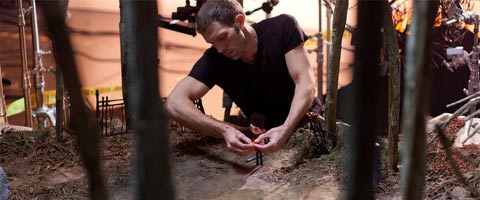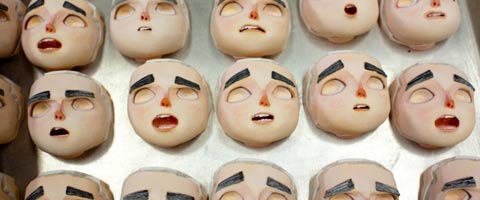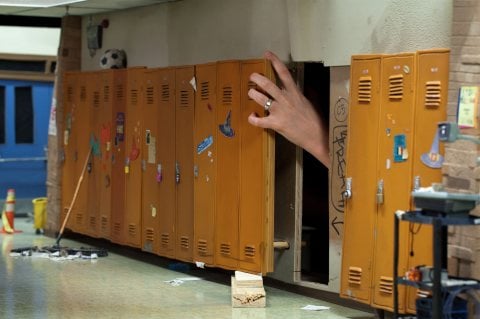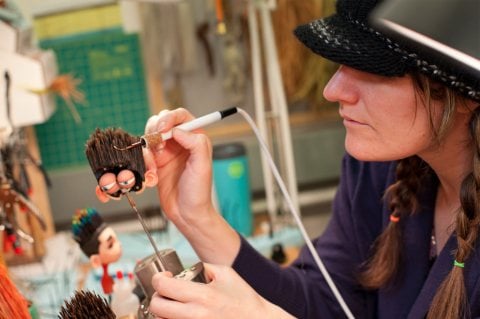Set Visit Report: Futuristic Technology And Lots Of Patience Behind The Scenes Of ParaNorman

It’s hard to imagine just how much skill, patience, control and endurance one has to have while making a stop-motion animated film. While most movies work to make you ignore the design process that went into the development of the world and story, on some level stop-motion animation invites you to peek in. The work not only features tiny imperfections that indicate hand-crafted artistry, but also the idea that it took hundreds of people working together photographing one frame at a time in order to make the project happen. But as monumental a task as one’s mind may make it, it wasn’t until I walked into Laika Studios to visit the set of ParaNorman that I realized just how breathtaking the entire effort is.
The film, based on a script by Chris Butler and directed by Butler and Sam Fell, follows a young boy named Norman (Kodi Smit-McPhee) who has the ability to speak to the dead. When he learns that an ancient curse threatens to destroy his town, he comes to the realization that it is his destiny to use his powers to fight off the forces of evil. The all-star cast also includes Anna Kendrick, Leslie Mann, Casey Affleck, John Goodman, Christopher Mintz-Plasse, Jeff Garlin and Elaine Stritch
Back during one early morning in late January, four journalists, including myself, boarded a plane to travel to Hillsboro, Oregon where we were given the chance to see not only the process behind the long-enduring craft of stop-motion, but also the fascinating, brilliant, futuristic technology that the studio is using and developing in order to make their films.

Making Norman Into The Boy He Is
When thinking about stop-motion animation most people think back to clay figures being bent and molded, but what Laika is creating is far, far more complex and interesting. Inside of each figure is an armature, which is basically a metal, bendable skeleton that makes up the body and joints of every puppet. The armatures are then put into a mold where they are cast into different characters using a synthetic latex-like material that feels eerily like human skin.
The heads of the puppets are fascinating as there are actually two different types that the studio implements. The first type is called “mechanical,” and is basically an armature for the face, filled with gears and switches. When covered by the face material, these mechanical faces can be manipulated to show different expressions. As you can imagine, there is a limit to the number of expressions that can be made using this type of head. For the characters that are featured in the film a lot and show a lot of emotions – such as Norman; his sister, Courtney; his friend Neil; or the bully, Alvin – they need to make what are called “replacements.” As the name suggests, this type allows the animators to remove the face of the puppet and replace it with a more accurate look. But how on Earth can they print enough faces to match all the various facial expressions shown by each character? You'll see by the end of this article, believe me.
As a result of each puppet being so intricately built and handled, there is a lot of wear and tear that goes on. For this Laika has an entire studio where artisans work on repairing various pieces and parts. Going through the various departments it was thrilling to see each crew member working so diligently with such tiny parts (you wouldn’t believe the size of some of the stitches made in the costume department). As you can imagine the number of man-hours makes each puppet quite valuable.
Your Daily Blend of Entertainment News
“You could have a very nice car for one of those,” co-director Sam Fell said later in an interview. “Brand new.”

The Life of The Animator
Let nobody ever say that the work of a stop-motion animator is easy because I can tell you for a fact it is not. At the studio we had the chance to visit three sets where members of the crew were hard at work quietly and carefully filming one frame at a time.
“I have, sometimes, slow motion dreams where I’m moving a frame at a time,” said Suzanne Twining, an animator working on a scene involving Norman in a school play. “I’m asleep, but my alarms going off, so I’m going [slowing moving each body part as she says it] ‘shoulder, arm, wrist, then follow the grid, then up, then down…”
But it’s not just the manipulation of the characters, but manipulation of the set as well. While touring the rigging department with Rigging Supervisor Oliver Jones, we got to see a stage set up where zombies were breaking out of the ground in a cemetery. Above the hole where the zombie is getting loose are pieces of dirt strung up on wires so that they will look like they are shooting out of the ground.
Not making the lives of the animators’ any easier is the advancing technology of the way we watch movies. High definition televisions are now the standard way to watch television and projectors in theaters are only getting better. As a result, the flaws of stop-motion animation are put under a microscope that they not work in their favor.
“I was worried about the whole HD thing, especially for TV, because you used to be able to get away with a lot of stuff, especially in stop-motion where not everything is perfect,” Twining said. “But, you know, it’s been okay, but I was a little worried. The last commercial I did we shot in HD and it was kind of like, ‘Urghhh,’ but it was okay. It all works out.”

The Big Boss
While many may envision the average Hollywood CEO as being a corporate fat cat sitting in a huge office burning money, when we were introduced to Travis Knight he was in the midst of setting up a giant forest made of corrugated cardboard and shredded paper, chicken wire, fake fur, AstroTurf and blown glass. In addition to being the president and CEO of Laika, Knight is also a producer on ParaNorman and, most impressively, the lead animator.
“I’ve been doing this for a long time and it still amazes me,” Knight said when asked if he is still impressed by the massive scale of the production. “It’s an astonishing group of people who would bend stuff every single day, and that kind of atmosphere just crackles with creativity…it’s inspiring to be a part of and it doesn’t get old.”
The studio broke out in 2009 with their first feature film, Coraline, which made nearly $125 million at the global box office. The movie put Laika on the map, but while ParaNorman does have some tonal similarities to Coraline (and, as Knight puts it “comes from the same DNA”) they are very different films.
“It’s not a fairytale, it’s more this kind of strange hybrid of a John Hughes-ian coming-of-age comedy and a George Romero/shambling zombie horror film, and kind of an Amblin-style adventure.
“It varies greatly in tone – it goes from humor and heartfelt stuff to excitement and danger and intensity and darkness. Just in terms of visually the way we approached it, we really did go for a more naturalistic style and it goes down to the materials that we choose to the way we’re lighting it, were using the camera, to the animation style. It’s much more of a skewed naturalism. So it’s not nearly as pose-y, it’s really well-observed – it draws from the things that we see people do. So it gives the characters and the setting a great verisimilitude, which I think makes the story more impactful.”
One key element that Coraline and ParaNorman do share, though, is that they both translate as horror movies for kids. What’s interesting about this, though is that it’s not a new phenomenon. Movies like A Nightmare Before Christmas and the upcoming Frankenweenie also share those horror roots. So what is it about stop-motion that makes it the perfect medium?
“There is something that is slightly inherently creepy about a puppet being brought to life. And so when you make a movie, because it’s an actual object that’s moving, so something just registers in your brain that that’s not quite right. But I think it creates a challenge when you’re trying to do a scene or a movie that has warmth and humor and heart because there’s an inherent thing with the process that’s a little bit off-putting, how do you then engage an audience so that you can overcome that? And one of the ways that you do that is by adjusting the animation style so can do that. By doing the kind of animation that we’re doing on this film, I think it gets rid of that weird kind of barrier between the audience of something kind of strange and an inanimate brought to life. So you do believe that these are living things.”

The Art of Rapid Prototyping
There wasn’t a single thing on the set of ParaNorman that didn’t blow my mind, but nothing I witnessed was as impressive or awe-inspiring as the process of rapid prototyping, also known as 3D printing.
When you break it down, the technology is a rather simple idea, but it’s the potential that’s so incredible. The printer functions by taking a 3D blueprint created by a designer on a computer and printing them out in physical form. What’s more, the machine isn’t limited to one kind of material, but instead can print in plastic, rubber, or even metal (and we’re talking titanium). The tech has actually been around for the last decade and was used by Laika to make Coraline, but what they are using now is even more advanced.
Primarily used by the studio to create replacement faces for each puppet so that they can express different emotions, the machines used on the set of Coraline were black and white printers that still required artists to paint in freckles, skin tone and more. For ParaNorman, however, they are using color printers that are actually able to consistently print out exact copies of the same design over and over again without inconsistencies.
With the use of the 3D printers, the team behind the film was able to produce approximately 8,000 different faces for Norman alone. Thanks to changeable and moveable pieces like eyebrows and mouths, this means that Norman can make about 1.5 million different facial expressions.
One major element that contributed to the fact that Laika could move to the more advanced equipment is that the price on the technology has declined massively in the last few years. According to Brian McLean, the Director of Rapid Prototype on ParaNorman, the studio paid $150,000 per black-and-white unit on Coraline and only $50,000 per color unit on ParaNorman. “You can get a little desktop unit for – a desktop plastic one – for probably $20,000,” McLean said. “So the price is really dropping.” In fact, he predicts that in 10 to 20 years the printers will be so affordable that you won’t go to Amazon to purchase a basketball, but will instead simply print one out.
But with the incredible advancements also comes questions for the moviemakers, namely how far you can push it before you’re just making advancements for advancements’ sake? “That’s one of the things that we really struggle with,” McLean said. “Making sure that the technology that we’re bringing into Laika and that Laika is adapting is pushing the artform forward. It’s not just, ‘We’re doing it because we can.’”
ParaNorman will be released on August 17th. Stay tuned later today when we post the first half of our interview with directors Sam Fell and Chris Butler! In the meantime, to see more from the movie check out two exclusive images from the set below. There's also even more over in our Blend Film Database.

This invading hand gives you a sense of the scale of both the characters and the sets-- this one, of course, is a school hallway.

Heidi Armour is at work making Norman's hair perfectly spiky.

Eric Eisenberg is the Assistant Managing Editor at CinemaBlend. After graduating Boston University and earning a bachelor’s degree in journalism, he took a part-time job as a staff writer for CinemaBlend, and after six months was offered the opportunity to move to Los Angeles and take on a newly created West Coast Editor position. Over a decade later, he's continuing to advance his interests and expertise. In addition to conducting filmmaker interviews and contributing to the news and feature content of the site, Eric also oversees the Movie Reviews section, writes the the weekend box office report (published Sundays), and is the site's resident Stephen King expert. He has two King-related columns.
